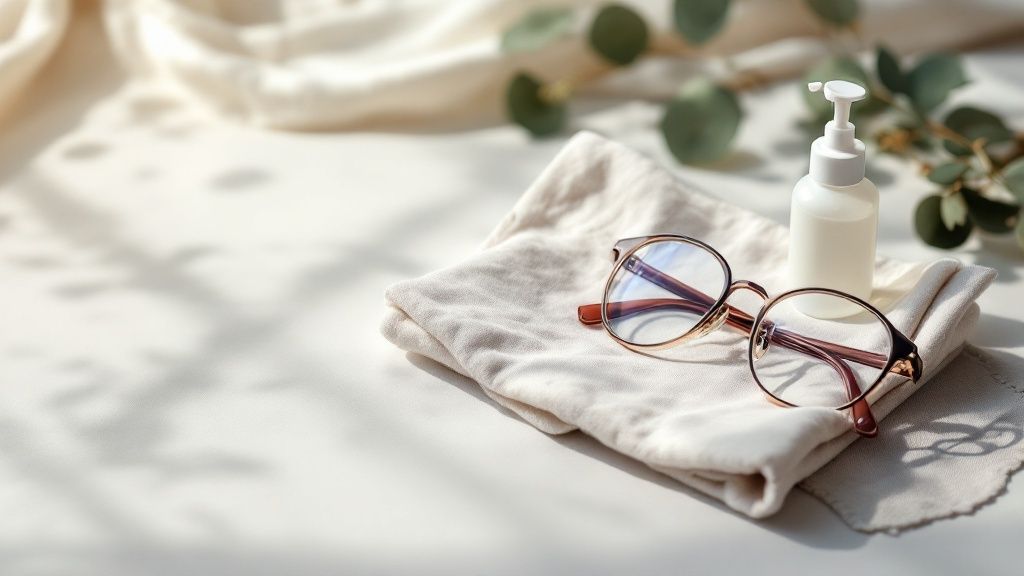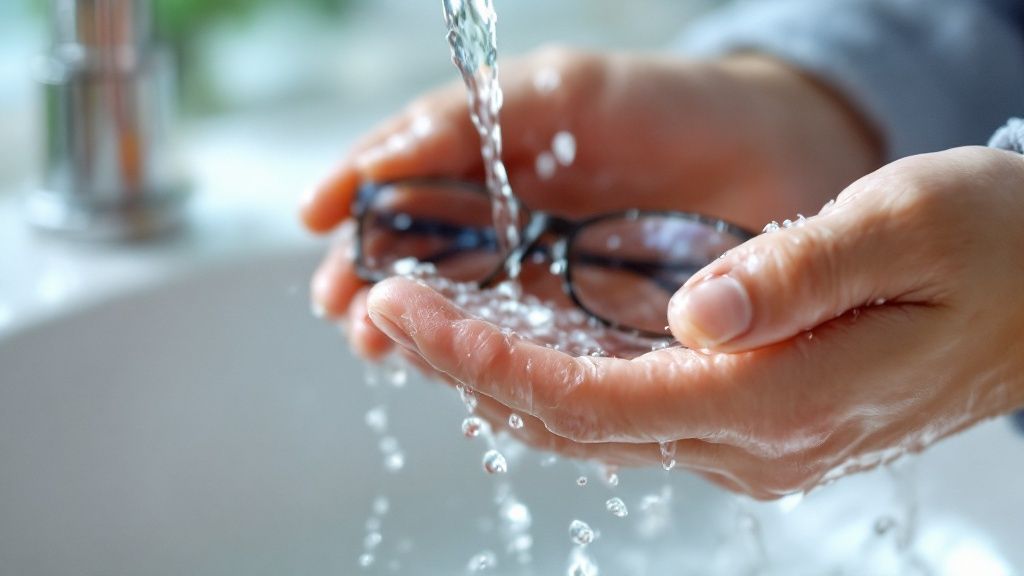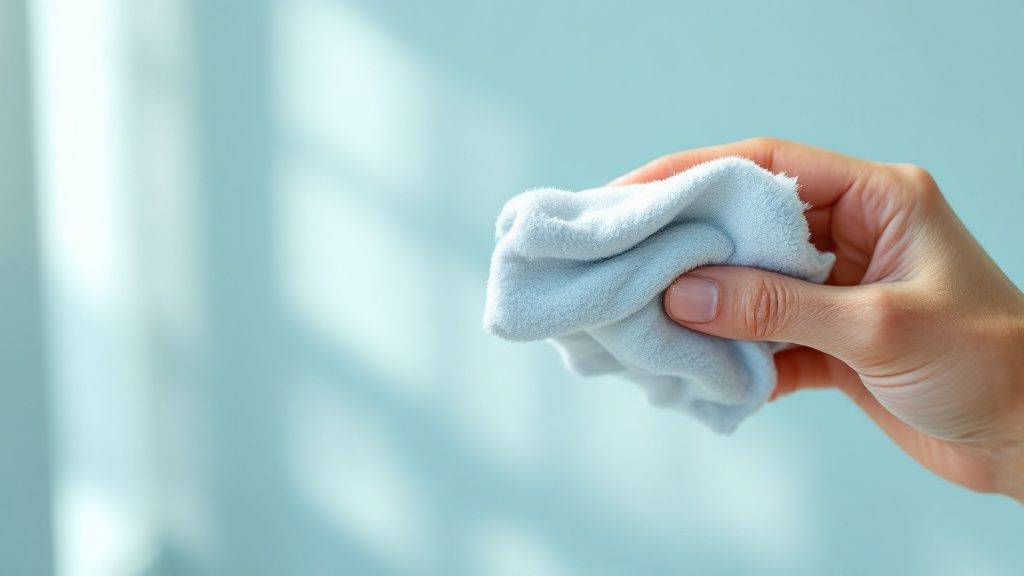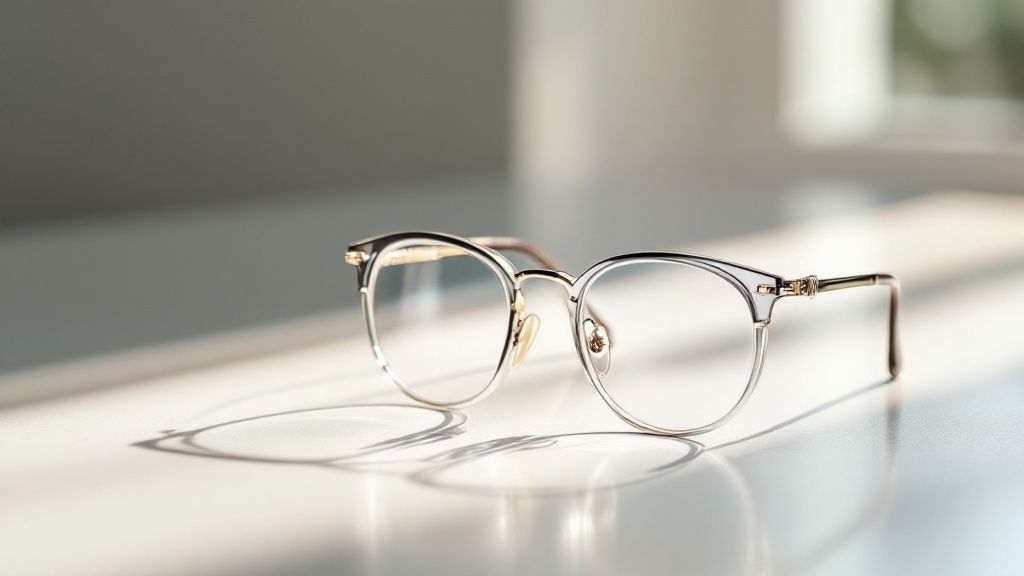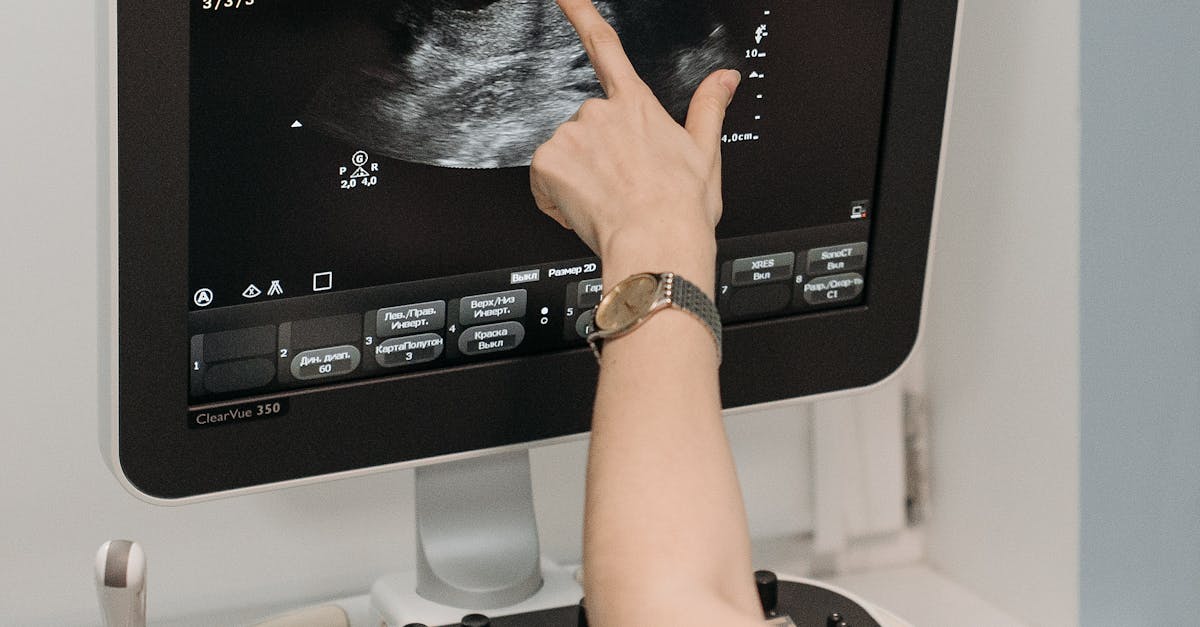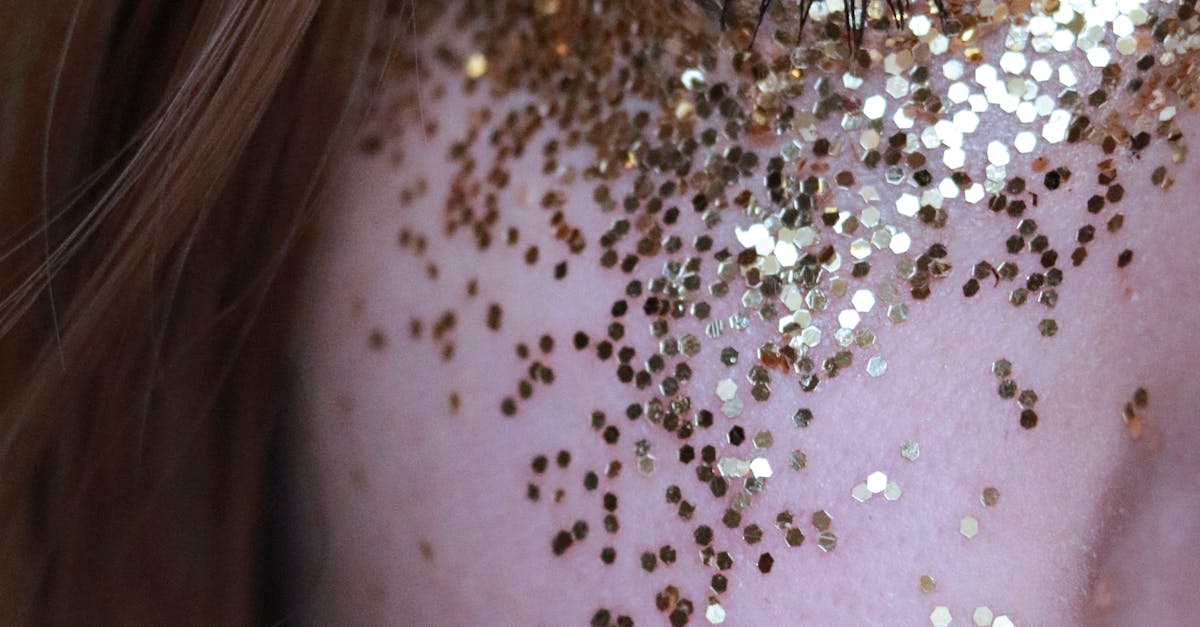The Hidden Impact of Properly Cleaned Eyeglasses
Beyond clear vision, proper eyeglass cleaning significantly impacts your overall eye health and the longevity of your eyewear. This isn't just about aesthetics; it's about protecting your investment and ensuring comfortable vision. Let's explore the often overlooked consequences of neglecting proper lens care.
The Science Behind Lens Deterioration
Microscopic particles, like dust, pollen, and debris, constantly come into contact with your eyeglasses. While seemingly insignificant, these particles gradually affect vision quality. This often occurs so slowly that you might not notice the changes. Furthermore, the natural oils from your skin transfer to the lenses every time you touch your glasses. Over time, these oils can interact with lens coatings, potentially reducing their effectiveness.
For example, anti-reflective coatings, designed to reduce glare, can become smudged and less effective because of oil buildup. This can result in increased glare, especially during nighttime driving or while using a computer. The consequences can include eye strain, headaches, and general visual discomfort.
The Hygiene Factor: More Than Just Cleanliness
Clean eyeglasses are more than just visually appealing; they're crucial for good eye hygiene. Eyeglasses, especially the frames and lenses, can harbor bacteria, often originating from human skin. A 2018 study revealed a substantial microbial load on worn eyeglasses, presenting potential risks for eye infections or serving as vectors for transmission in clinical settings. Cleaning with alcohol-impregnated lens wipes proved highly effective, reducing bacterial contamination by up to 96%. This highlights the importance of using proper cleaning methods. Learn more about this research here: Bacterial Contamination of Eyeglasses. This bacterial buildup can lead to eye irritation, infections, and other eye-related problems.
The Cost of Neglect: Replacing vs. Maintaining
Neglecting proper cleaning can drastically shorten the lifespan of your eyeglasses. Scratched lenses and damaged coatings not only impair vision but also lead to more frequent replacements. This can become costly over time. However, dedicating a few minutes daily to proper cleaning can save you money on replacements and dramatically improve your visual comfort. Proper care helps your eyeglasses stay in optimal condition, providing clear vision and lasting comfort for years to come.
Lens-Damaging Habits You're Probably Doing Daily
That quick wipe of your eyeglasses on your shirt may seem harmless, but it could be causing more harm than good. This section explores common lens-damaging habits you might be practicing daily without realizing it. While convenient in the moment, these habits can lead to microscopic damage that accumulates, impacting the clarity and longevity of your lenses.
The Problem With "Convenient" Cleaning
Many people instinctively grab the nearest piece of fabric, often their shirt, to clean their eyeglasses. This feels like a quick fix, but it’s actually a recipe for scratches. Clothing fibers, especially cotton, can act like sandpaper on your lenses, creating micro-abrasions that affect clarity.
The dust and dirt already on your clothing contribute further to the damage. This seemingly innocent act can significantly shorten the lifespan of your eyewear. Studies show that using fabric on lenses can lead to significant damage, particularly to lens coatings. Learn more about this issue: Why You Shouldn't Clean Your Eyeglasses With a Shirt.
The Dangers of Paper Products and Household Cleaners
Paper towels and tissues might seem soft, but their texture can scratch delicate lens coatings. These materials are designed for absorbency, not for cleaning delicate surfaces. Likewise, using household cleaners on your eyeglasses is detrimental.
The chemicals in these cleaners can damage lens coatings, such as anti-reflective and scratch-resistant layers. This can lead to decreased vision quality and more frequent lens replacements.
Hot Water and the Breakdown of Coatings
Another damaging habit is using hot water to clean eyeglasses. While effective for other cleaning purposes, hot water can accelerate the deterioration of lens coatings. The heat can break down the chemical bonds in the coatings, making them less effective.
Oleophobic coatings, designed to repel oil, are particularly vulnerable to damage from hot water. Anti-reflective coatings can also become cloudy or peel when exposed to high temperatures.
The Breath-and-Wipe Myth
Breathing on your lenses to create condensation before wiping might seem harmless. However, this can actually contribute to lens damage. The small droplets of saliva in your breath can contain acidic components that, over time, can etch the lens surface.
This method often involves using a shirt or tissue to wipe away the moisture, increasing the risk of scratches. Instead, use a designated lens cleaner and a microfiber cloth. This preserves your lenses and maintains their clarity, especially important for anti-glare coatings and other specialized lens treatments.
Building Your Essential Eyeglass Cleaning Arsenal
Maintaining clean eyeglasses is crucial for clear vision and the longevity of your lenses. Not all cleaning methods are created equal. Selecting the right tools and techniques can significantly extend the life of your eyeglasses and protect your investment. This section explores the essential components of a proper eyeglass cleaning kit and why quality matters.
Choosing the Right Cleaning Solution
Effective cleaning solutions are specifically formulated for eyeglasses. These specialized solutions gently remove dirt, oil, and smudges without damaging delicate lens coatings. Avoid using household cleaners, which can strip away protective layers, especially anti-reflective coatings. Opt for solutions that are isopropyl alcohol-based, as these are generally safe for most lens types. However, always consult the manufacturer’s recommendations for your specific lenses to ensure compatibility.
The Importance of Microfiber Cloths
Microfiber cloths are indispensable for cleaning eyeglasses. Their incredibly fine fibers effectively trap dirt and oil without scratching the lens surface. Premium microfiber cloths are denser and offer superior cleaning power compared to cheaper alternatives. Look for tight weaving and a soft texture. These are indicators of a high-quality cloth that will effectively clean your lenses.
Proper care of your microfiber cloth is also essential. Regularly hand wash it with a mild, bleach-free soap and allow it to air dry. This will maintain its effectiveness and prevent the buildup of dirt and oils that could potentially scratch your lenses.
Exploring Ultrasonic Cleaners
For a truly deep clean, consider an ultrasonic cleaner. These devices use high-frequency vibrations to create tiny bubbles that dislodge dirt and grime from hard-to-reach areas, such as nose pads and hinges. Ultrasonic cleaners are excellent for removing stubborn buildup. However, check frame material compatibility before using one, as certain materials may not be suitable for this cleaning method.
Sprays vs. Wipes: On-the-Go Cleaning
Lens cleaning sprays generally offer a more thorough clean than pre-moistened wipes. However, pre-moistened wipes provide the convenience of quick touch-ups while on the go. Ideally, build both a comprehensive home cleaning station and a compact travel kit to be prepared for all situations.
Budget-Friendly Options That Work
While some budget-friendly cleaning methods can be effective, others can cause irreparable damage. Diluted, lotion-free dish soap can be a cost-effective cleaning solution. Avoid harsh chemicals like ammonia or bleach, which can damage lens coatings. While the cheapest option may seem appealing, some seemingly economical solutions can cost more in the long run due to potential lens damage.
Investing in quality cleaning products ensures the longevity of your eyeglasses and helps maintain optimal vision.
To help illustrate the costs and benefits of various cleaning options, consider the following comparison:
To help you navigate the options available, the following table provides a comparison of popular eyeglass cleaning products:
Comparison of Eyeglass Cleaning Products
| Product Type | Effectiveness | Average Cost | Convenience | Best For |
|---|---|---|---|---|
| Microfiber Cloth | High | $5 – $15 | High | Daily cleaning |
| Cleaning Spray | High | $5 – $10 | Medium | Thorough cleaning at home |
| Pre-moistened Wipes | Medium | $5 – $15 | High | Quick cleaning on the go |
| Ultrasonic Cleaner | Very High | $20 – $100 | Low | Deep cleaning, removing buildup |
| Dish Soap (Diluted) | Moderate | Very Low | Low | Emergency cleaning |
This table summarizes the key features of each cleaning product, helping you select the right tools for your needs. Remember, investing in quality products and proper cleaning techniques will preserve your eyeglasses and ensure clear vision for years to come.
The growing emphasis on eye health and hygiene has led to an expansion of the global lens cleaning products market. In 2023, this market was valued at approximately $2.1 billion USD. It's projected to grow at a 4.1% compound annual growth rate from 2024 to 2032. This growth is fueled by factors such as technological advancements and the increased use of eyeglasses and digital devices. Learn more: Lens Cleaning Products Market.
The Perfect Clean: A Master Class in Lens Care
Transform your eyeglass cleaning routine with this expert guide to lens care. We'll cover the entire process, from preparation to inspection, highlighting often-neglected areas like nose pads and hinges. These spots attract oils and debris, impacting both the look and performance of your eyewear.
Preparing Your Glasses for Cleaning
Before starting, make sure your hands are clean and dry. This simple step prevents transferring dirt and oils to your lenses. Next, rinse your glasses under a gentle stream of lukewarm water. This removes loose dust and debris, preventing potential scratches during wiping. Avoid hot water, as it can harm certain lens coatings, especially on high-quality lenses.
The Cleaning Process: A Step-by-Step Guide
- Apply Lens Cleaner: Use a specifically designed eyeglass cleaning solution on both sides of the lenses. Avoid household cleaners, which can be too harsh.
- Gentle Cleaning: With a clean microfiber cloth, gently wipe the lenses in a circular motion. Start from the center and move outwards for even cleaning and minimal scratching.
- Focus on Details: Pay close attention to the nose pads and hinges. These areas trap oils and debris. A cotton swab dipped in lens cleaner works well for these tight spots.
- Rinse and Dry: Rinse the glasses under lukewarm water to remove any leftover cleaning solution. Dry the lenses and frame with a clean microfiber cloth kept solely for eyeglass cleaning.
Advanced Cleaning Techniques
For stubborn residue, consider an ultrasonic cleaner. These devices use vibrations to remove buildup. For anti-reflective coatings, specific cleaning solutions can restore effectiveness and minimize glare. Photochromic lenses need special care. Consult your optician for recommendations on maintaining their light-adjusting features.
Handling Your Eyeglasses: Preventing the Fingerprint Cycle
How you handle your glasses significantly impacts cleaning frequency. Always hold your glasses by the temples. This minimizes oil transfer from your fingers. Store your glasses in a protective case when not in use to shield them from damage. These habits reduce cleaning frequency and maintain lens clarity. This, in turn, improves your visual experience.
Inspecting Your Eyeglasses
After cleaning, check your glasses for smudges or streaks. Repeat the process if necessary. Taking a few extra moments for thorough cleaning extends the life of your eyewear and ensures optimal vision. Proper care protects your investment and provides the clearest possible view.
Keeping Your Vision Crystal Clear All Day Long
Maintaining perfectly clean eyeglasses involves more than just a quick wipe each day. It requires understanding the science behind lens care and implementing proactive strategies to keep your lenses clear between thorough cleanings. This approach not only ensures optimal vision but also helps your eyewear last longer.
Understanding Why Glasses Fog Up
Have you ever walked from a cold environment into a warm one and experienced that annoying foggy film on your glasses? This happens because of condensation. Warm, humid air contacts the cooler surface of your lenses, causing water vapor to condense into tiny droplets that obscure your vision. Similarly, activities like cooking or exercising can also create fog due to increased humidity and temperature fluctuations.
Fortunately, several effective anti-fogging solutions are available, ranging from sprays and wipes to specialized lens coatings. Testing these products in real-world scenarios can help you find the one that works best for your lifestyle.
Preventing Oil Transfer and Smudges
Fingerprints are a common nuisance for eyeglass wearers. These smudges result from the transfer of oils from your fingers to your lenses. However, simple adjustments to how you handle your glasses can make a big difference.
- Hold by the Temples: Always handle your glasses by the temples (the side arms) instead of touching the lenses directly.
- Use a Microfiber Cloth: Keep a microfiber cloth readily available for quick cleanings. Avoid using your shirt or other fabrics, as these can scratch your lenses.
Smart Storage Solutions
Proper storage is crucial for protecting your glasses from scratches, dust, and accidental damage. A sturdy protective case is a must-have when you're not wearing your glasses.
- Designated Storage Spot: Choose a consistent, safe spot for your glasses case, like your bedside table or a desk drawer. This helps prevent misplacing them and minimizes the risk of damage.
- Travel Cases: For added protection while traveling, invest in a compact travel case designed specifically for eyeglasses.
Quick-Fix Cleaning in Emergencies
Sometimes you'll find yourself without your usual cleaning supplies. In these situations, a few quick-fix methods can be a lifesaver.
- Running Water Rinse: Rinsing your glasses under lukewarm water can remove loose debris and smudges. If possible, gently dry them with a clean, soft cloth to prevent water spots.
- Microfiber Cloth in a Pinch: Even without cleaning solution, a microfiber cloth can effectively remove light smudges and dust.
Maintaining clean eyeglasses is about more than just clear vision; it's about protecting your eye health and extending the life of your eyewear. Eyeglasses are a vital tool for vision correction, used by billions globally. Estimates suggest that between 25% and 60% of the population needs eyeglasses, with over 4 billion people relying on them worldwide. This highlights the importance of proper care and maintenance. Learn more: Eyeglass Cleaning Tips. By incorporating proactive habits and understanding the principles of lens care, you can maintain crystal-clear vision throughout your day, regardless of your activities.
Specialized Techniques for Every Type of Eyewear
Different types of eyewear require specific cleaning approaches. Using standard methods on specialty glasses can lead to damage and diminished performance. This section examines the unique cleaning requirements for various eyewear, from designer frames to safety glasses. Knowing these specialized techniques will help you protect your investment and maintain optimal vision.
Designer Frames and Decorative Elements
High-end designer frames often feature intricate details and delicate materials. Cleaning these frames requires a gentle touch and specialized products. Avoid harsh chemicals that could damage decorative elements or coatings.
Instead, opt for a pH-neutral lens cleaner and a soft microfiber cloth. When cleaning around embellishments, use a cotton swab dipped in cleaner for precise application. This targeted approach prevents damage while ensuring thorough cleaning.
Impact-Resistant Safety Glasses
Safety glasses are designed to withstand impact, but their protective coatings can be susceptible to certain cleaning methods. Avoid abrasive cleaners or rough cloths that can scratch the lenses and compromise their protective qualities.
Use a mild soap and water solution, rinsing thoroughly and drying with a clean microfiber cloth. This gentle approach preserves the integrity of the safety features.
Delicate Rimless Designs
Rimless eyeglasses require extra care due to their minimalist construction. The screws and delicate hinges are particularly vulnerable to damage from harsh cleaning methods.
When cleaning rimless glasses, avoid bending or twisting the frames. Use a lens cleaning spray specifically designed for eyeglasses and a microfiber cloth. Pay close attention to the areas where the lenses attach to the frame, ensuring they are clean and free of debris.
Specialized Lens Materials and Coatings
Different lens materials and coatings have specific cleaning requirements. Polycarbonate lenses, commonly used in sports eyewear, are highly impact-resistant but can be prone to scratching. Use a lens cleaner designed for polycarbonate and a microfiber cloth.
Hydrophobic coatings repel water and oil, making cleaning easier. However, these coatings can be damaged by harsh chemicals. Use a gentle lens cleaner and a soft microfiber cloth. Photochromic lenses darken automatically in sunlight. To maintain their performance, clean them with a lens cleaner specifically designed for photochromic lenses.
Blue-light filter lenses block harmful blue light emitted from digital screens. Clean these lenses with a microfiber cloth and a lens cleaner that is safe for coated lenses. Additionally, the COVID-19 pandemic heightened awareness around hygiene, impacting the lens cleaner market by increasing the demand for effective and convenient solutions like pre-moistened wipes. Explore this topic further: Lens Cleaner Market Report.
Cleaning Frequency and Environmental Factors
How often you clean your eyeglasses depends on your usage patterns, environmental conditions, and lens technology. If you work in a dusty environment, you may need to clean your glasses more frequently. If you live in a humid climate, you might experience more fogging and require specialized anti-fog products. Those with oily skin may need to clean their lenses more often to remove smudges.
To help summarize the cleaning requirements for different eyewear types, the following table provides a quick overview of special considerations, recommended products, cleaning frequency, and things to avoid.
Cleaning Requirements by Eyewear Type
| Eyewear Type | Special Considerations | Recommended Products | Cleaning Frequency | Avoid |
|---|---|---|---|---|
| Designer Frames | Delicate materials, decorative elements | pH-neutral cleaner, microfiber cloth | As needed | Harsh chemicals, abrasive cloths |
| Safety Glasses | Protective coatings | Mild soap and water, microfiber cloth | As needed | Abrasive cleaners, rough cloths |
| Rimless Designs | Delicate hinges and screws | Eyeglass cleaner, microfiber cloth | As needed | Bending or twisting frames |
| Polycarbonate Lenses | Prone to scratching | Polycarbonate lens cleaner, microfiber cloth | As needed | Harsh chemicals, abrasive cloths |
| Hydrophobic Coatings | Sensitive to harsh chemicals | Gentle lens cleaner, microfiber cloth | As needed | Harsh chemicals, abrasive cloths |
| Photochromic Lenses | Light-sensitive, requires specialized care | Photochromic lens cleaner, microfiber cloth | As needed | Harsh chemicals, abrasive cloths |
| Blue-Light Filter Lenses | Protect coatings | Lens cleaner safe for coatings, microfiber cloth | As needed | Harsh chemicals, abrasive cloths |
This table provides a concise guide for maintaining various types of eyewear. By understanding the specific needs of your eyewear, you can ensure its longevity and optimal performance.
Future-Proofing Your Eyewear Investment
Properly cleaning your eyeglasses is essential for maintaining their longevity. This section explores preventative care and maintenance practices that can significantly extend the lifespan of your eyewear, protecting both your vision and your financial investment.
Environmental Factors and Your Eyewear
Environmental factors like UV exposure and temperature fluctuations can significantly impact your glasses over time. UV radiation can degrade certain frame materials and lens coatings. Prolonged exposure to sunlight can cause some plastic frames to become brittle or discolored. Extreme temperatures can also affect the integrity of lens coatings, potentially leading to cracks or peeling.
Consider the impact of temperature changes in everyday situations. Leaving your glasses in a hot car on a summer day can warp plastic frames and damage lens coatings. Similarly, extreme cold can make some frames more susceptible to breakage.
Adapting Your Cleaning Routine to Seasonal Changes
Your eyeglass cleaning routine should adapt to seasonal changes. In the summer, increased perspiration and sunscreen application can lead to more frequent smudging, requiring more regular cleaning. In the winter, dry air can cause static cling, attracting dust and debris to your lenses.
Using a slightly damp microfiber cloth can be beneficial during colder months to help remove these particles.
Professional Cleaning: When and Why It Matters
While regular DIY cleaning is crucial, professional cleanings offer additional benefits. Opticians have specialized tools and cleaning solutions to remove stubborn buildup in hard-to-reach areas like hinges and nose pads. They can also identify early signs of wear and tear, enabling timely repairs that prevent further damage. Regular professional attention can prevent small issues from becoming major problems.
The DIY Approach: Saving Money and Your Frames
Many maintenance tasks can be effectively handled at home. Regularly tightening loose screws prevents further frame damage and ensures a secure fit. Inspecting your glasses for any signs of damage and addressing them promptly can also prevent costly replacements down the line.
Recognizing the Warning Signs
Opticians often encounter eyewear damage resulting from improper care. Persistent smudges despite regular cleaning, difficulty removing debris, and noticeable scratches on the lenses are all indicators that your current cleaning methods may need adjustment. Simple changes, like switching to a microfiber cloth or using a designated lens cleaner, can drastically improve the condition of your eyewear.
Proper maintenance can substantially increase the lifespan of your glasses. With consistent care, you can potentially double or even triple the usable life of premium eyewear, translating to significant savings and ensuring clear, comfortable vision for years to come. This preventative approach safeguards your investment and maintains optimal visual performance.
Experience the difference professional eye care and high-quality eyewear can make. Visit iDoctor – Chicagoland’s Premier Destination for Exceptional Eye Care & Designer Eyewear, Chicagoland's premier destination for exceptional eye care and designer eyewear. We offer comprehensive eye exams, contact lens fittings, and a curated collection of high-end eyewear brands. Schedule your appointment today.


